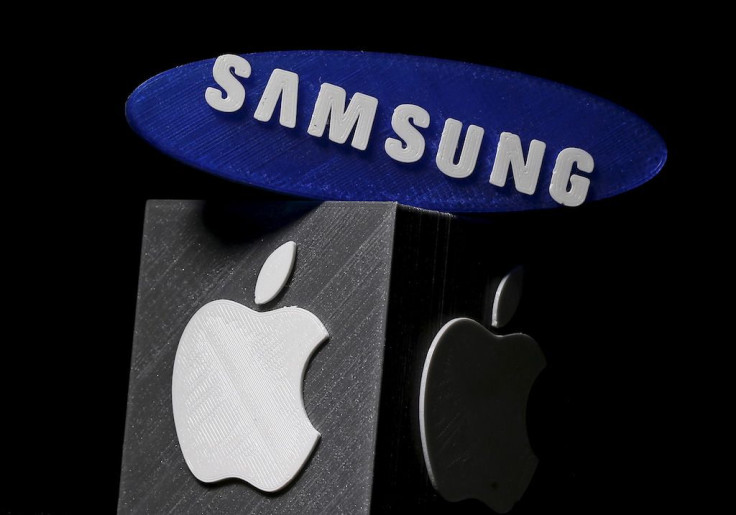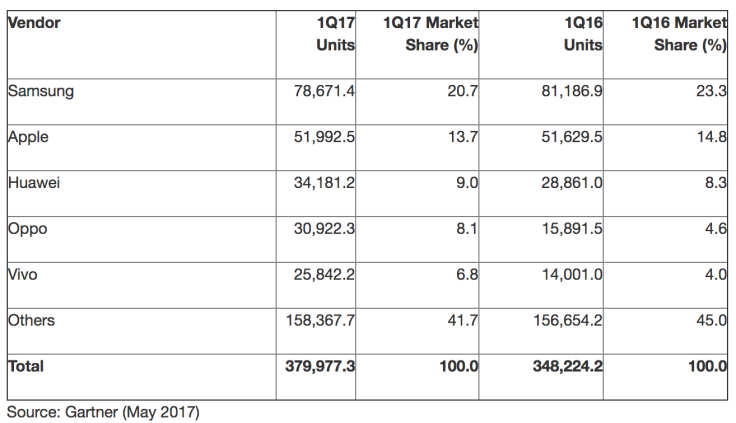Apple, Samsung Lose Market Share In Q1 2017 Due To Trio Of Chinese Brands

The global smartphone market grew by 9.1 percent in the first quarter of 2017 thanks to the Chinese phone makers Huawei, Oppo and Vivo. Meanwhile, Apple and Samsung both saw their market shares drop in the same period.
“The top three Chinese smartphone manufacturers are driving sales with their competitively priced, high-quality smartphones equipped with innovative features,” Gartner research director Anshul Gupta said. “Furthermore, aggressive marketing and sales promotion have further helped these brands to take share from other brands in markets such as India, Indonesia and Thailand.”

The combined market share of Huawei, Oppo and Vivo now accounts for 24 percent of the global smartphone market, which is up by 7 percent from the same period in 2016. Global smartphones sales totaled 380 million units in the first quarter of 2017.
Samsung’s smartphones sales declined by 3.1 percent. Although preorders for the Galaxy S8 and S8 Plus are up by 30 percent year over year, the absence of an alternative to the ill-fated Galaxy Note 7 is one of the major reasons Samsung is losing market share, TechCrunch reported.
As for Apple’s iPhone, Gartner reported iPhone sales were flat. Apple’s sales declined by 1.1 percent with a Q1 2017 market share of 13.7 percent. Apple’s performance is being threatened by Oppo, Vivo and other brands which may have hindered Apple from selling more iPhones in China.
Although Samsung and Apple’s global smartphone market shares are down from the same period last year, the two brands remain on top. Samsung takes the No. 1 spot with 78.6 million units sold in Q1 2017 while Apple takes second place with 51.9 million units.
Huawei appears to be catching up with Apple with 34.18 million units sold, followed by Oppo and Vivo with 30.9 million and 25.8 million units, respectively. Although Huawei is getting closer to Apple’s numbers, it’s also under pressure from competing Chinese brands.
The Huawei P9 and P9 Plus, which has been out now for more than a year, remains popular, helping Huawei to position itself in the third spot. With the Huawei P10 and P10 Plus, the phone maker could continue doing well in the second quarter.
Vivo has sold nearly 26 million units during the first quarter of 2017. The brand was able to achieve a market share of 6.8 percent, up from 4 percent from Q1 2016. This accounts for a growth of 84.6 percent. Sales for Vivo smartphones grew more than 220 percent thanks to its popularity in emerging markets in Asia/Pacific.
Oppo, which is quickly catching up to Huawei, saw a 94.6 percent increase in worldwide smartphone sales in Q1 2017. Oppo had the best performance in the quarter and has retained its No. 1 spot in China.
One of the reasons Oppo continues to do well is because it focuses on improving its cameras and fast charging capabilities. Another reason is Oppo’s strategy when it comes to selling its devices. The company focuses on selling its smartphone through retailers instead of relying heavily on selling its products online.
As for the operating system market, Google’s Android OS remains No. 1 while Apple’s iOS stays in second. Android market share grew by 2 percent while iOS only grew by 0.9 percent year over year, MacRumors reported. Android’s continued growth is due to the increasing acceptance of the OS by Chinese brands that have manufactured high-end smartphones.
© Copyright IBTimes 2024. All rights reserved.





















